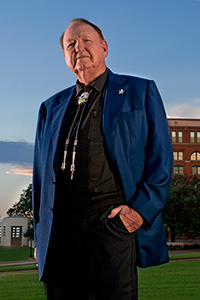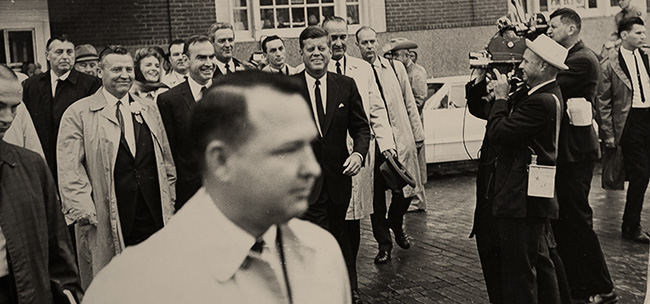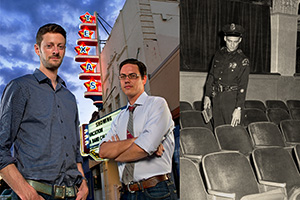
Secret Service Agent Mike Howard ('60) looked into the eyes of the possible killer of President John F. Kennedy.
Kennedy had been shot earlier that day — Nov. 22, 1963 — from the Texas School Book Depository while riding in a motorcade through downtown Dallas. Howard was interviewing a man who witnesses saw had a rifle with a scope in the backseat of his car as he got gas in Fort Worth. The man refused to answer any questions.

Howard was tired and upset, having worked seven days and nights before the Kennedys arrived in Fort Worth. He showed his Secret Service ID. The man laughed.
Howard pulled out his gun and pressed it to the suspect's nose.
"Young man," he told him. "I don't have time to mess with you."
After that, Howard says, "this fellow began to talk as fast as he could."
The man explained he had just picked up his father's gun, which was being repaired in Dallas.
The true suspect in the shooting of Kennedy and Texas Gov. John B. Connally — Lee Harvey Oswald — was arrested at the Texas Theatre in Dallas and would soon be shot dead by bar owner Jack Ruby in the basement of the Dallas Police Headquarters.
Fifty years later, Howard still vividly remembers the horrifying day in American history that shook the world.
He is among many UNT alumni who were involved in the events of that day, from attending to Kennedy at Parkland Hospital to reporting on the events for the media.
Even younger alumni who were not alive then are preserving the legacy of that day as owners of the historic Texas Theatre, which now hosts movies and events, and as museum staff for The Sixth Floor Museum at Dealey Plaza, housed in the former Texas School Book Depository building.
For Howard, the interrogation of the young suspect was just the beginning of what would be a long weekend.
Howard had been recruited to join the Secret Service on the recommendation of his North Texas government professor Sam B. McAlister.
After the Kennedys visited Fort Worth, they flew to Dallas.
Howard and two other agents remained to check their hotel room for national security risks. But they rushed to Dallas when they saw TV reports that shots were fired.
After Howard and other agents checked out possible suspects, Lyndon B. Johnson, who had just been sworn in as president, ordered the Secret Service to look out for Oswald's family and appointed Howard to find and put them into protective custody.
Howard and another agent found the family -- Oswald's wife, Marina, their two small children and his mother, Marguerite — at a hotel near Dallas Love Field and moved them to an Arlington hotel for their safety. On the drive, they heard a police radio report concerning Oswald. Marina, who couldn't speak English well, asked if Howard could tell her what was going on.
"Yes, ma'am. Your husband has been shot," he told her.
For the next seven days, Howard, his colleagues and a Russian interpreter were holed up in that hotel to interview Marina.
"She never shed a tear," Howard says. "She never showed any emotion."
They also had to arrange for Oswald's funeral and keep their bosses updated three times a day. Meanwhile, some assistants picked up clean clothes from Howard's wife, Martha, at their home in Saginaw.
"When you're in the Secret Service, you go through all this training," he says. "We didn't think about anything else. We were there to do a job."
He and his Secret Service team released their tapes to the Warren Commission, which investigated Kennedy's death.
Howard then was assigned to protect the new first daughter, Lynda Bird Johnson, in Austin. He protected President Johnson's family until 1974, when he retired from the Secret Service and went to work in private security. He still keeps in touch with the family, and five White House Christmas cards hang on his living room wall.
Howard, a government and history major, says, "It was a profession built for me. I loved every minute of the Secret Service."

Sue Carrico ('57) was at home in Irving, eating lunch and taking care of her small children when CBS newscaster Walter Cronkite interrupted As the World Turns with the breaking news that Kennedy had been shot.
She instantly tried to call her husband, the late Jim Carrico ('57), who was then a second-year surgery resident at Parkland Hospital in Dallas.
The lines were busy. Eventually, one of his colleagues called her. Jim was the first surgeon to attend to Kennedy.
He didn't come home that night. The next day, when Sue picked him up, his dress shirt still had Kennedy's blood on it. They washed it in the bathtub, trying to erase the tragic event.
"He was extremely tired and did not talk a lot about it," she says. "None of the doctors did, for years and years."
Jim Carrico took notes about what he did in the trauma room, as required daily by the hospital, four hours after he saw Kennedy. He testified before the Warren Commission and many years later donated the notes to The Sixth Floor Museum. But he didn't speak about it in detail until 30 years later — after time made it easier to talk about and his residents wanted to hear about it.
"That's the way the doctors were," Sue says. "They didn't ask for any fame and they didn't think it was right to have recognition for something so tragic."
The assassination was the first major event in Jim's career. A specialist in trauma surgery, he served as chair of the surgery departments at the University of Washington in Seattle and the University of Texas Southwestern Medical Center in Dallas. He was active in the American College of Surgeons and was president-elect in 2002 when he died from colon cancer.
The Carricos met in California and began dating their freshman year as students at North Texas. Sue was an elementary education major, and Jim, whose father, James L. "Kit" Carrico ('27), was a longtime chemistry department chair, built the foundation for his medical career as a chemistry major. He was named a Distinguished Alumnus in 1991 for his professional achievements.
Still, that November day looms large. Actor Zac Efron plays Jim Carrico in the movie Parkland, which will be released this fall. The Carricos later found out that they lived near the same neighborhood in Irving as Oswald's wife and went to the same barber and grocery store as Oswald.
"There were so many little coincidences," Sue says. "It does seem surreal."

Keith Shelton ('72 M.J.), then the political writer for the Dallas Times Herald, was sitting in the first press bus of the presidential motorcade when he heard three to four shots near the triple underpass where Elm, Commerce and Main streets converge.
Shelton at first hoped a car was backfiring, but he had served in the U.S. Army.
"I knew what rifle shots sounded like," he says.
Shelton, along with other journalists trained at North Texas, were about to cover the story of their lives. They had followed Kennedy as he spoke to enthusiastic crowds throughout Texas earlier that week, despite animosity toward him from some in the state.
Associated Press reporter Mike Cochran ('58) had just come back from Kennedy's departure at Carswell Air Force Base after his speech in Fort Worth that morning. When he returned to the Fort Worth Star-Telegram office, he passed the news desk and quipped, "Well, we got him out of town safely."
Several minutes later, the copy boy reading the news wire screamed that Kennedy had been shot.
Cochran hopped in a car with several staffers and headed to Parkland Hospital, not knowing Kennedy's fate. When he got there, Cochran says, "a wave of nurses came down the hall crying hysterically and suddenly we knew."
While Cochran spent the day at Parkland covering medical reports on the wounded Gov. Connally, Shelton was assigned to cover the reaction at the Trade Mart, where Kennedy was scheduled to speak. The mood was grim, as the tables had been ready with steaks and yellow roses. The presidential seal had been taken down. The guests, many of whom were weeping, slowly got up and left. Shelton began compiling firsthand accounts from witnesses.
"It was very emotional," says Shelton, who worked for the Times Herald until 1965, then worked as managing editor for the Denton Record-Chronicle. He later earned his master's degree and taught for 23 years at UNT.
"Our challenge was to keep the reporters in the field calm enough to get the facts right and the people in the office calm enough to take the information," he says.
But the shocking events would continue that weekend. On Sunday, Associated Press reporter Peggy Simpson ('60) was assigned to watch the routine transfer of Oswald from the city jail to the county jail. She was 8 feet away when Ruby shot Oswald.
As the cops were wrestling with Ruby, she ran to a bank of telephones and called the bureau's office. She stayed on the phone for 45 minutes describing the scene to her editors.
"You just put yourself on automatic pilot and don't think," says Simpson, who later covered Congress for the Associated Press, worked for the Boston Herald and Ms. magazine and now freelances in Washington, D.C. "You tell them everything you see and hear."
Oswald's funeral was in Fort Worth on Monday. When Cochran arrived, he realized no one was there but federal officers, the police, the media and Oswald's family. The scheduled minister didn't even show up.
"There was no one to carry the casket," he says. "So they recruited reporters. I was one of the first ones they asked. I told them not only 'no,' but 'hell no.'"
But when the United Press International reporter stepped up to carry the casket, Cochran quickly changed his mind and joined the others.
Later that evening, Cochran went home and watched reruns of Kennedy's funeral on TV.
"That's when everything about those four days in November hit me," says Cochran, who worked for the Associated Press most of his career and has written several books. "I finally had time to sit and think and shed a few tears."
Also among the journalists writing the first draft of history that weekend were Bill Mercer ('66 M.A.) and Bob Huffaker ('69 M.A., '74 Ph.D.), reporting for Dallas' CBS affiliate. Future faculty member Mercer spoke with Oswald, and Huffaker relayed the events of his shooting death live to the national television audience. They wrote about their experiences in the 2007 book When the News Went Live: Dallas 1963, coming out this fall in a 50th anniversary edition.
Other alumni also have been preserving accounts and artifacts. Will Pry ('11), mobile editor for The Dallas Morning News, compiled the recollections of the paper's staff writers for the iBook, JFK Assassination: The Reporters' Notes. And Jim Marrs ('66) has written about the conspiracy theories in his 1989 book Crossfire: The Plot That Killed Kennedy, which served as the basis for Oliver Stone's film JFK.
UNT's archives include The Kennedy Assassination Oral History Project, with interviews of journalists and other witnesses, as well as the papers of Judge Sarah T. Hughes, who swore in Johnson as president. And the UNT Portal to Texas History contains the Dallas Police Department photo collection, which has many images from the weekend's events.

Two alumni are safeguarding the history of the day in a unique way — they're preserving a building.
Philosophy alum Adam Donaghey ('02) and RTVF alum Barak Epstein ('01), with two other business partners, operate the Texas Theatre, which shows movies and hosts other events.
They also run a film production company, Aviation Cinemas Productions. Its films include a documentary and the upcoming Casolaro, based on a journalist's mysterious death.
While similar theaters have been razed, the Texas Theatre still stands and was added to the National Register of Historic Places in 2003. At least once a day, a visitor comes to see the spot where Dallas police captured Oswald. Visitors continue to be intrigued with the theater's history, and its owners have embraced it, even selling T-shirts bearing Oswald's face.
"The Oswald connection has been both the bane and savior of the theater," Donaghey says. "The T-shirts are us accepting history. Branding a shirt with images of such significance seemed as natural as branding with our marquee."
Visitors also can get closer to history at The Sixth Floor Museum, which includes a 45,000-item collection of artifacts, documents and oral history interviews and 6,000 items in its library. Jim Carrico and Shelton contributed to the oral history project, which preserves personal accounts about the day Kennedy was shot.

Katie Womack ('00) works as collections manager, caring for and preserving the items in the museum's permanent collection. She is especially intrigued by the scrapbooks people put together about the events and have since donated.
"Many people cut things out of the newspaper and saved other related material," she says. "Seeing the things people collect is an interesting reminder of how this event touched so many."
Krishna Shenoy, the museum's librarian/archivist who is pursuing her master's in library science, manages the Reading Room, in which visitors can pour through books, publications and DVDs about Kennedy and the assassination. The room, on the first floor of the Texas School Book Depository building, faces Dealey Plaza where the motorcade passed.
"You're sitting right where the tragedy happened," she says. "It can be an emotional experience for visitors. It's really remarkable how deeply people were affected."
Remember JFK
Events surrounding JFK assassination impact journalists' careers